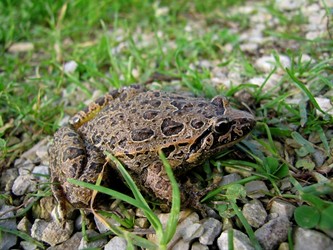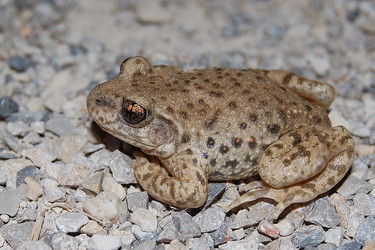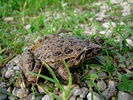Discoglossidae
Discoglossid frogs
David Cannatella- Spondylophryne

- Scotiophryne

- Prodiscoglossus

- Pelophilus

- Paradiscoglossus

- Latonia

- Baranophrys

- Alytes
- Discoglossus
Introduction
This family includes two living genera, Discoglossus and Alytes. Both are small frogs (Snout vent-length about 40-70 mm). The family is distributed in Europe and northwest Africa (Arnold et al., 1978).
Discoglossus (Painted Frogs) resemble true frogs of the genus Rana; they are somewhat smooth and shiny. The shape of the pupil is like an inverted teardrop. Painted frogs are usually found in and around water.
Midwife toads (Alytes) are stockier, more toadlike, and more terrestrial, being found in woodlands and rocky areas. The male of Alytes obstetricans carries the strings of eggs, adherent to his back and thighs, until they hatch into water. The tadpoles are ordinary pond-type tadpoles with median spiracle, beaks, and two upper and three lower rows of denticles.
Alytes muletensis was first described as a new genus, Baleaphryne, from Pleistocene fossil material. It was only later discovered that the species was still extant on the island of Mallorca, which is part of Spain (Hemmer and Alcover, 1984). The genus Baleaphryne was later synonymized into Alytes.
With the removal of Bombina and Barbourula from Discoglossidae, the fossil range of the family is unclear. See below under "Phylogenetic Relationships."
Discussion of Phylogenetic Relationships
Discoglossidae is the node-based name for the ancestor of Alytes + Discoglossus, and its descendants. By this definition, some fossils currently referred to "Discoglossidae", such as †Eodiscoglossus and †Latonia, likely will be excluded when their phylogenetic relationships are understood. The synapomorphies of Discoglossidae include a V-shaped parahyoid bone (convergent with Pelodytes) and a narrow epipubic cartilage plate (Cannatella, 1985).
Almost all workers have placed Alytes, Discoglossus, Bombina, and Barbourula in the same taxon, although the dissimilarity of Alytes and Discoglossus, on one hand, and Bombina on the other has often been noted (e.g., Lanza et al., 1976). Synapomorphies of Discoglossanura (Ford and Cannatella, 1993) reject the monophyly of "Discoglossidae" as traditionally used. However, Hay et al. (1995) found Bombina orientalis and Discoglossus pictus to be closest relatives; this supports the traditional arrangement of the Discoglossidae.
References
Click here for general list of references
Title Illustrations

| Scientific Name | Discoglossus galganoi |
|---|---|
| Location | Paul da Tornada, Portugal |
| Specimen Condition | Live Specimen |
| Source | Ră-de-focinho-pontiagudo (Discoglossus galganoi) |
| Source Collection | Flickr |
| Image Use |
 This media file is licensed under the Creative Commons Attribution-NonCommercial-NoDerivs License - Version 2.0. This media file is licensed under the Creative Commons Attribution-NonCommercial-NoDerivs License - Version 2.0.
|
| Copyright | © 2006 Pedro Henriques |
| Scientific Name | Alytes obstetricans |
|---|---|
| Location | Cassaniouse - 15 - France |
| Specimen Condition | Live Specimen |
| Source | Alytes obstetricans |
| Source Collection | Flickr |
| Image Use |
 This media file is licensed under the Creative Commons Attribution License - Version 2.0. This media file is licensed under the Creative Commons Attribution License - Version 2.0.
|
| Copyright | © 2007 David GENOUD |
About This Page
If you are interested in authoring or co-authoring the page for this taxon, or some part of it (even a species), contact David Cannatella.
David Cannatella

University of Texas, Austin, Texas, USA
Correspondence regarding this page should be directed to David Cannatella at
Page copyright © 1995 David Cannatella
 Page: Tree of Life
Discoglossidae. Discoglossid frogs.
Authored by
David Cannatella.
The TEXT of this page is licensed under the
Creative Commons Attribution License - Version 3.0. Note that images and other media
featured on this page are each governed by their own license, and they may or may not be available
for reuse. Click on an image or a media link to access the media data window, which provides the
relevant licensing information. For the general terms and conditions of ToL material reuse and
redistribution, please see the Tree of Life Copyright
Policies.
Page: Tree of Life
Discoglossidae. Discoglossid frogs.
Authored by
David Cannatella.
The TEXT of this page is licensed under the
Creative Commons Attribution License - Version 3.0. Note that images and other media
featured on this page are each governed by their own license, and they may or may not be available
for reuse. Click on an image or a media link to access the media data window, which provides the
relevant licensing information. For the general terms and conditions of ToL material reuse and
redistribution, please see the Tree of Life Copyright
Policies.
Citing this page:
Cannatella, David. 1995. Discoglossidae. Discoglossid frogs. Version 01 January 1995 (under construction). http://tolweb.org/Discoglossidae/16973/1995.01.01 in The Tree of Life Web Project, http://tolweb.org/










 Go to quick links
Go to quick search
Go to navigation for this section of the ToL site
Go to detailed links for the ToL site
Go to quick links
Go to quick search
Go to navigation for this section of the ToL site
Go to detailed links for the ToL site